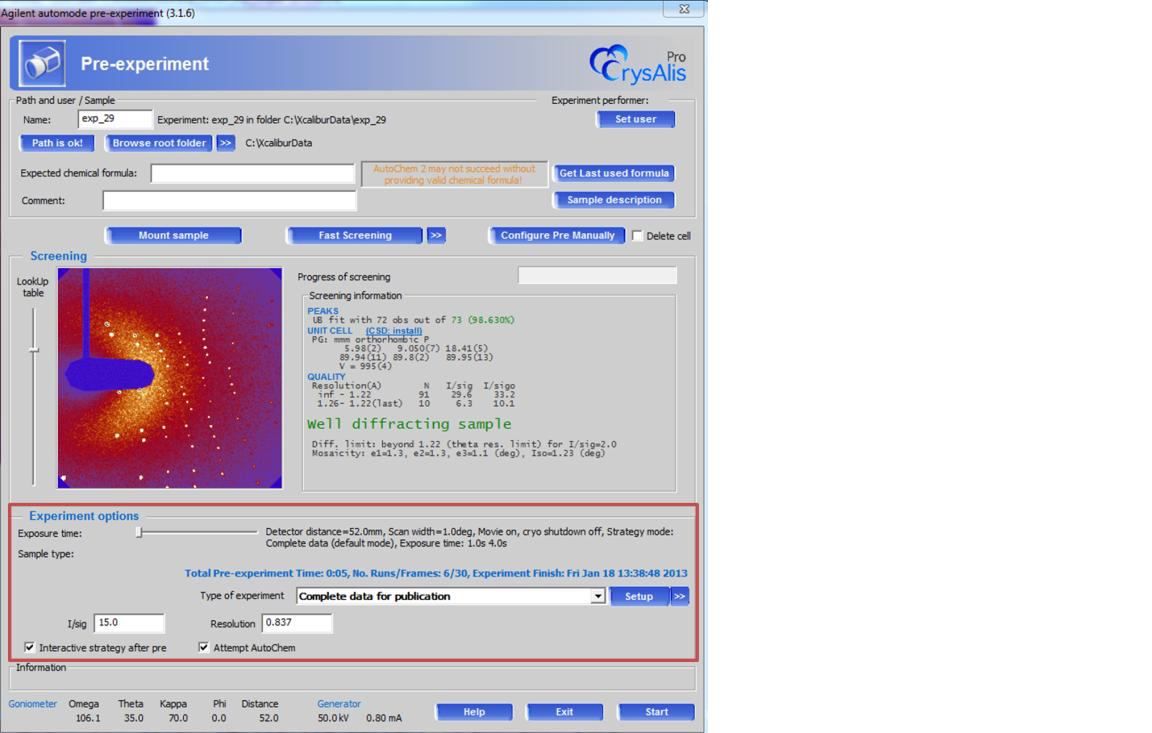
Use Tools -> Polar Pattern to make a linearized ring pattern and an interpolated profile(use clear profiles to remove previous profiles): Use the visualization to confirm the result(the thick black line is the sharpest) and then clear the visualization by clicking the Clear Profiles button: Use the Tools -> Recenter(Sharpen Peaks) tool to refine the center of the rings by finding the center where the peak at your first marked ring is the sharpest: This removes single crystal peaks from the profile. Implements polar pattern with the median instead of the mean. This is designed to remove the affect of the beam stop on the intensity Implements polar pattern profile that has outliers removed. A new profile is made based on the average of that image. Makes an interpolated polar transformed image of the ring pattern resulting in straight vertical lines. Polar pattern must be redone after re-centering the pattern. This tool to refines the center of the ring pattern by finding the center where the peak at your first marked ring(on the main screen) is the sharpest. The background subtraction is lost when subsequently performing a polar pattern or recenter The fit curve is then subtracted from the profile. You can have up to 3 peak simulationsĪ dialogue to change the scatting vector limit(x-max) and Polar Pattern background image preferencesįits a 3-points point power law to the main beam falloff by selecting 3-point that lie on the falloff. It also set the colour as well as the legend label and relative intensity. This makes shows a profile simulation that has broadening.Ī dialogue that allows the peaks to be labeled with hkl indexes. Overlays a GDIS powder diffraction simulation with a wavelength of 0.5, U,V,W set to 0.8 and pseudo-viogt mixing to 0.8. This makes shows peak centers and intensities Overlays a GDIS powder diffraction simulation with a wavelength of 0.5 and U,V,W set to 0. cif file and simulate the peaks and profile of the crystal diffraction Images/screen05.png Profile Screen Toolbar NameĬlick on a peak to mark and measure the maximaĬlears the profile visualizations and peak labels Input the known d-spacings(the defaults are for gold) for the rings you marked and click calibrate and then close the dialogue:Ĭlick the Profile button or select Tools -> Profile to get the profile of the ring pattern in the Profile Screen: If you don't know your resolution of your detector, Mark a few rings and open the Tools -> Calibration dialogue. Set your accelerating voltage, camera length and resolution of your TEM in the Edit -> Preferences dialogue. The gamma slider at the bottom can help when marking dim rings: You must mark at least one ring to make a profile or calibrate your detector. Use the Mark Rings tool and click 3 points on a ring to mark it. Use the Zoom tool to make the rings larger: Open a TEM ring pattern using Pattern -> Open. Used to set the Accelerating Voltage, Camera length and Resolution of the patternĬalculation the resolution of the pattern by comparing up to 4 marked ring with know d-spacings.
#Singlecrystal software dm3 file windows
dm3 fileĮxits the program and closes all profile and ring figure windows Removes marks made on the figure one by one Opens the profile screen with the calculated pattern profile

emf doesn't work)Ĭlick 3-ponts on a ring to measure the d-spacing and mark the centerĬlick 2-points to measure the distance in d-space Left-click and drag makes zoom-in box/Right-click and drag makes zoom-out boxĪdjust the space on the outside of the figure axes Button Search for the file DM3 on Wikipedia.Left-click and drag pans the pattern/Right-click and drag zooms the pattern


We provide data concerning the manufacturer of this type of software and if necessary refer you to valuable sites that contain more detailed information in the area of interest. The purpose of our site is to provide all relevant information on available programs, the use of which will enable to start, make changes, and even to save the file with any extension.
#Singlecrystal software dm3 file professional
These are the most frequently asked questions to which one can find professional answers on our pages. We have included on our pages information about all the file extensions with their brief description and programs to run them. DM3 belongs to the "Raster Image Files" category. The most common file format with the extension. DM3 file, which is associated with the 2 file types. It also happens that the file extension is associated with a number of different file formats. The file extension allows the operating system or the user of the device to recognize its format and use the appropriate program that allows to run it.


 0 kommentar(er)
0 kommentar(er)
